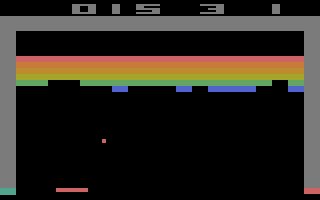
 The Game: You’ve got a mobile paddle and – well, frankly, balls. But you don’t have a lot of balls at your disposal (am I the only one becoming a little bit uncomfortable discussing this?), so you have to make the best use of them that you can to knock down the rows of colorful bricks overhead. Missing one of your precious balls – and we all know how painful that can be – forces you to call another ball into play. Losing all of your balls, as you’ve probably guessed by now, ends the game. So, in essence, Breakout is a metaphor for life from the masculine perspective. (Atari, 1978)
The Game: You’ve got a mobile paddle and – well, frankly, balls. But you don’t have a lot of balls at your disposal (am I the only one becoming a little bit uncomfortable discussing this?), so you have to make the best use of them that you can to knock down the rows of colorful bricks overhead. Missing one of your precious balls – and we all know how painful that can be – forces you to call another ball into play. Losing all of your balls, as you’ve probably guessed by now, ends the game. So, in essence, Breakout is a metaphor for life from the masculine perspective. (Atari, 1978)
 Memories: Breakout is a fine adaptation of the game created by a one-time early Atari employee named Steve Jobs (who got a lot of help from his friend Steve Wozniak; these two later founded a computer company named after a common fruit). As the original arcade game wasn’t all that complex, the VCS version doesn’t need to overcome any technical hurdles. And yet it does!
Memories: Breakout is a fine adaptation of the game created by a one-time early Atari employee named Steve Jobs (who got a lot of help from his friend Steve Wozniak; these two later founded a computer company named after a common fruit). As the original arcade game wasn’t all that complex, the VCS version doesn’t need to overcome any technical hurdles. And yet it does!
The arcade Breakout achieved its on-screen colors only with the use of a multi-colored transparent overlay on its monitor, not unlike the original Odyssey console’s claim to playing multiple games because it had ping pong, tennis and hockey overlays for buyers’ TV screens. Not so here! Through the magic of advanced technology, VCS Breakout generated all of its colors internally.
Even those colorful balls of yours.
Breakout continues on to this day, recently revived in, of all things, a quest-style  3-D game released under Hasbro Interactive’s Atari imprint. Its play mechanics are among the most-copied basic game tenets in video and computer game history. Ever think about that? Put little feet and eyes and antennae on the bricks, give them a somewhat more hostile intent, and what do you get? Space Invaders.
3-D game released under Hasbro Interactive’s Atari imprint. Its play mechanics are among the most-copied basic game tenets in video and computer game history. Ever think about that? Put little feet and eyes and antennae on the bricks, give them a somewhat more hostile intent, and what do you get? Space Invaders.